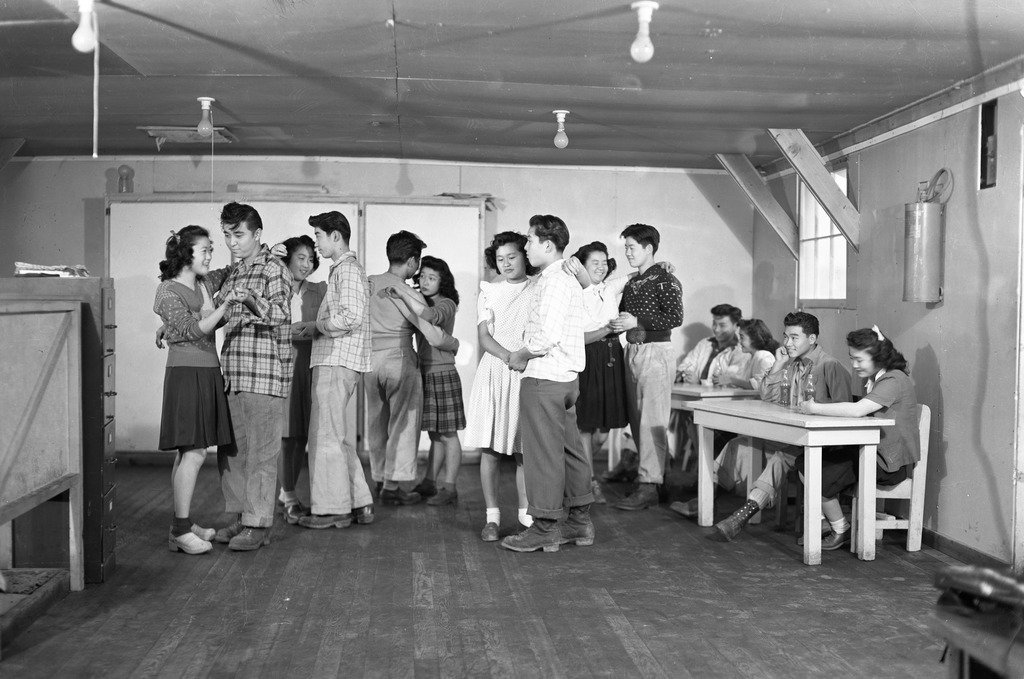Youth Hi-Lites — To Be Young: Teenage Life at Minidoka
To Be Young: Teenage Life at Minidoka
By Sara Ziegler
Friends of Minidoka High School Summer Intern, One Stone School, Boise
A dance at Minidoka
https://ddr.densho.org/ddr-fom-1-409/?format=img
One’s teen years are filled with emotion, hopes, desires, and dreams. Who will I become? Who will I love? Where do I go from here? After Executive Order 9066, the act that allowed for the exclusion of Japanese Americans, many American teens had the futures they may have imagined for themselves torn away. Instead, they were forced into a new life in the dusty, forgotten corners of this nation, at isolated concentration camps like Tule Lake, Manzanar, and Minidoka, for no reason other than the way they looked. There was a stripping away of one’s basic rights, one’s free will in the poor conditions and alienating daily life on camp.
The teens at camps like Minidoka found ways to look for a silver lining in each other, despite the difficulties of camp life. Often, this came in the form of social activities. In 1943, there was a vocal concert at Hunt High School, the local high school at Minidoka. It featured the Girls Chorus, the Male Chorus, and “an A Capella choir of 200 voices.” (The Minidoka Irrigator). Teens also found connection in the form of parties and galas. In 1945, students at the Hunt High School were able to sponsor a Mardi Gras Gala, which featured “a fish pond, ring toss, penny pitch, ice cream parlor,” and more. (The Minidoka Irrigator). At many of these events, there was a young woman voted Miss Mardi Gras, or, at other events, a Sweetheart on Valentine’s Day or May Day. Teens at Minidoka loved to watch films, play sports like baseball with friends, and in 1945, a “Teenage Canteen” was built with a game room, lounge, and snack bar. A quick Google search provides one with the definition of canteen - “a place of recreation and entertainment for people in military service.”
The Hunt High School featured popular sports teams as well, such as track or baseball. According to Kay Endo, a Minidoka survivor, sports were a favorite activity at camp, from basketball to baseball. “We just played ourselves, you know, we played pick up games. But they did have the high school and the other teams, they did have a baseball team which was very good, excellent teams and they played the teams out in the community from Twin Falls and Filer and Buhl and all the surrounding communities…there’s one player named Hank Matsubu, he went on and signed a professional contract with the Pittsburgh Pirates” (Densho.)
Another Minidoka survivor, Mits Takahashi, remembers a bit about social life in camp. “There was a block dance almost every weekend, I would say…I think that was one of the biggest things at least teenagers from my age looked forward to.” He also talks about dating among Nisei. “I imagine the parents were quite concerned about not so much the boys, with the girls I think they were. Because they really didn’t have strict control over them…As a casual date, I think chances of going in and meeting the family and things were very, very rare” (Densho). Takahashi also says dating at Minidoka was often pretty casual, and the atmosphere at camp made dating a bit different than dating elsewhere. Teens would make dates to go to dances and just say, “I’ll meet you there?” rather than picking each other up from the barracks.
However, despite the ways in which teens found connection with each other, the camp had an issue with teenage delinquency. Minidoka was an isolated, monotonous, and desolate place to live out your coming of age, and many Minidoka teens were drawn to minor crime and disobedience. The canteen space for teens that was set up in 1945 was a first step in curbing this problem, according to The Minidoka Irrigator.
Imagine your teen years…who were you then? What did you want? As a teen at Minidoka, the freedom you had imagined for yourself was stripped away. The cold, drafty barracks had no privacy. The confinement of the concentration camp became a prison, surrounded by barbed wire and guard towers. Days were often spent working long hours in the agricultural fields. There were no trips to the seaside with friends, no malls, no kisses on ferris wheels. It is easy to dismiss the years spent at Minidoka as a tragedy, and in many ways it was, but it was also someone’s life. Someone’s coming of age. Think about your own teen years. How would it have been different within the confinement of Minidoka? What would you have done to survive?
Works Cited
The Minidoka Irrigator. 1943. University of Washington Library,
https://www.lib.washington.edu/specialcollections/collections/exhibits/harmony/minidoka/i
rrigator/1943/hunt-high-vocal-concert-to-be-presented-june-11. Accessed June 24 2022.
The Minidoka Irrigator. 1945. University of Washington Library,
https://www.lib.washington.edu/specialcollections/collections/exhibits/harmony/minidoka/i
rrigator/1943/hunt-high-vocal-concert-to-be-presented-june-11. Accessed June 24 2022.
The Minidoka Irrigator. 1944. University of Washington Library,
https://www.lib.washington.edu/specialcollections/collections/exhibits/harmony/minidoka/i
rrigator/1944/our-delinquency-problems.. Accessed June 24 2022.
The Minidoka Irrigator. 1945. University of Washington Library,
https://www.lib.washington.edu/specialcollections/collections/exhibits/harmony/minidoka/i
rrigator/1945/teen-age-canteen-scheduled-for-opening-next-month. Accessed June 24 2022.
The Minidoka Irrigator. 1943. Library of Congress,
https://www.loc.gov/resource/sn84024049/1943-01-20/ed-1/?sp=4&q=hunt+high+school.
Accessed June 24 2022.
Ash, Carol. Russell, Mia. Wakatsuki, Hanako. Images of America: Minidoka National Historic Site.
Arcadia Publishing. 2018. pg. 83. Pg. 77. Pg. 57.
Endo, Kay. Conducted by Richard Posashin. Manzanar National Historic Site Collection. Densho. 24 July
2010.
Takahashi, Mits. Conducted by Tom Ikeda. Densho Visual History Collection. Densho. 30 March 2008.

